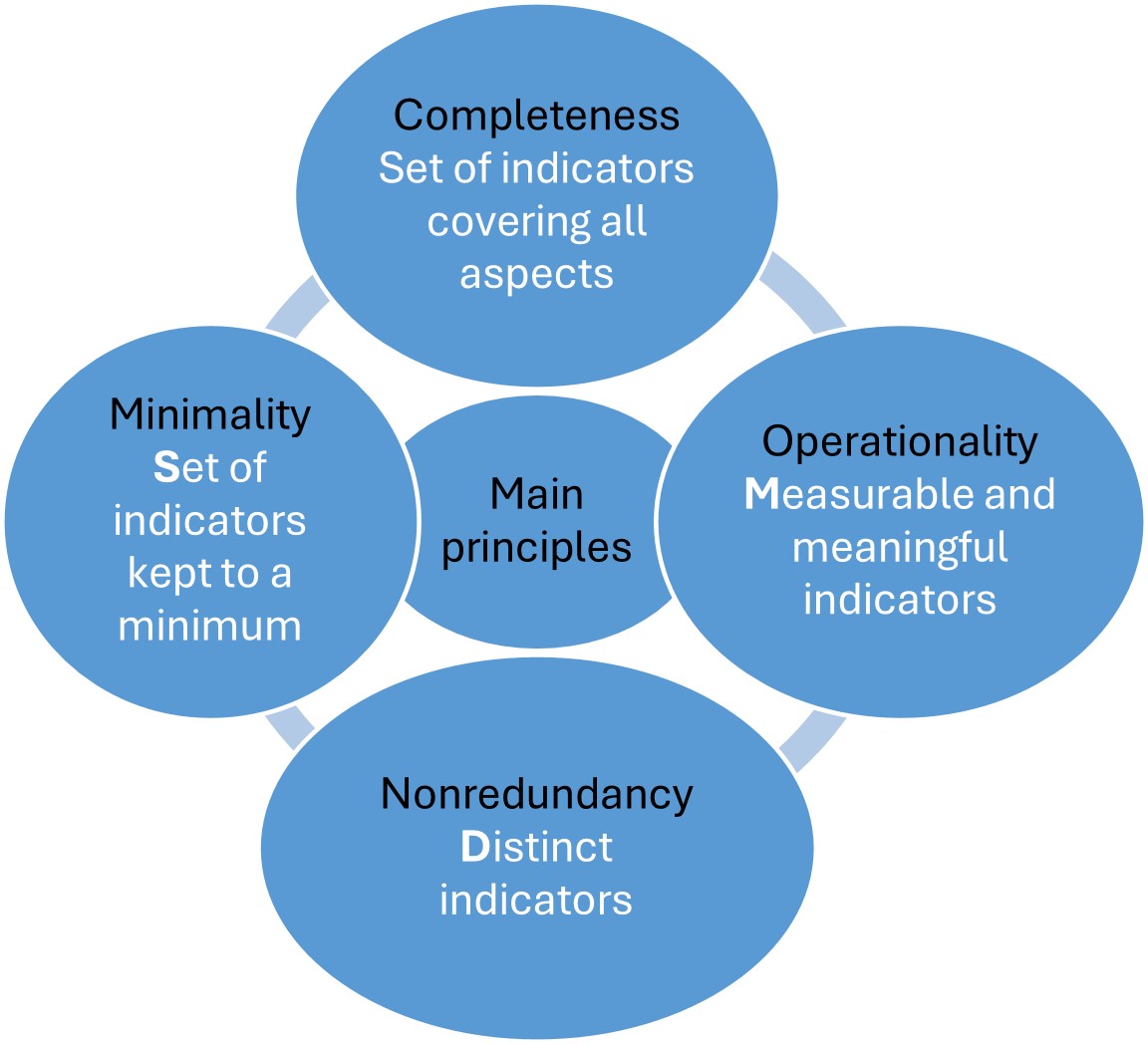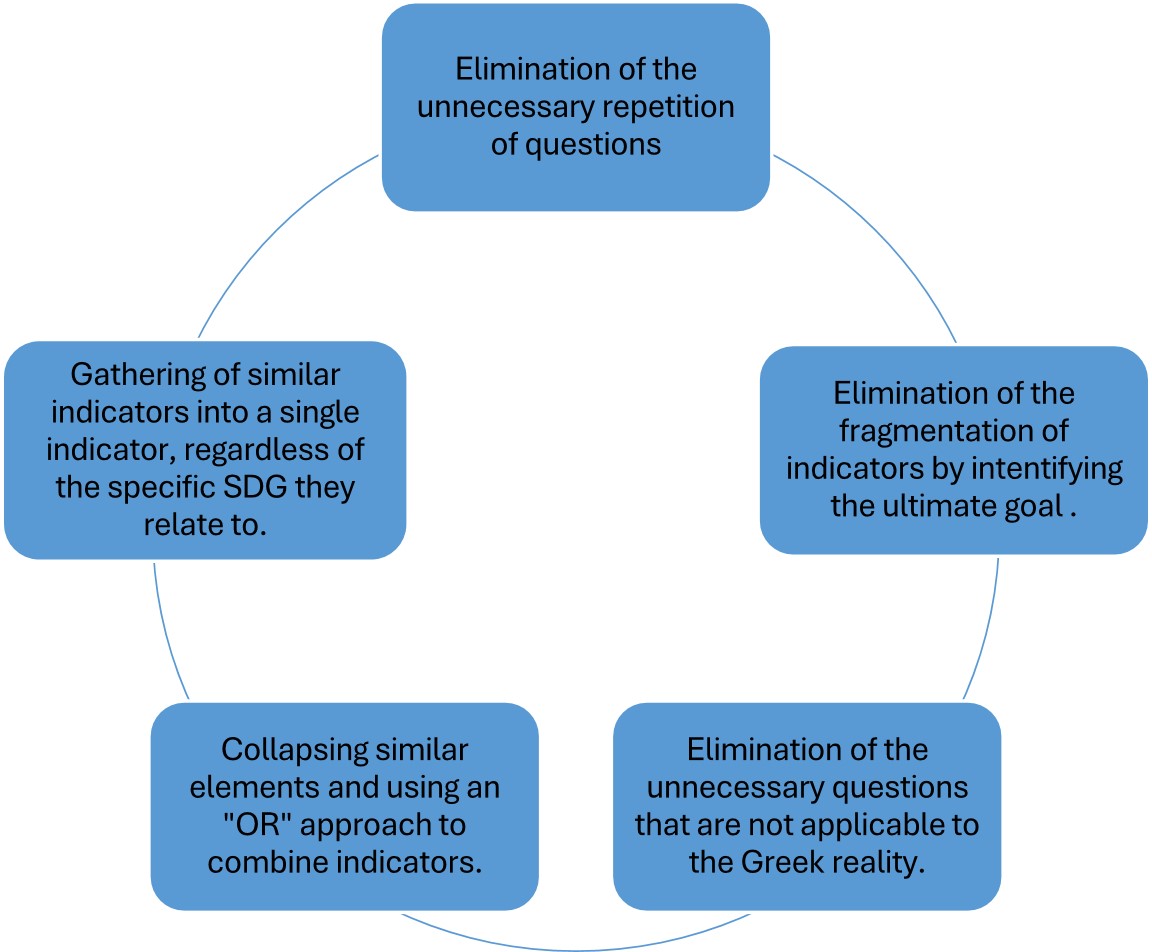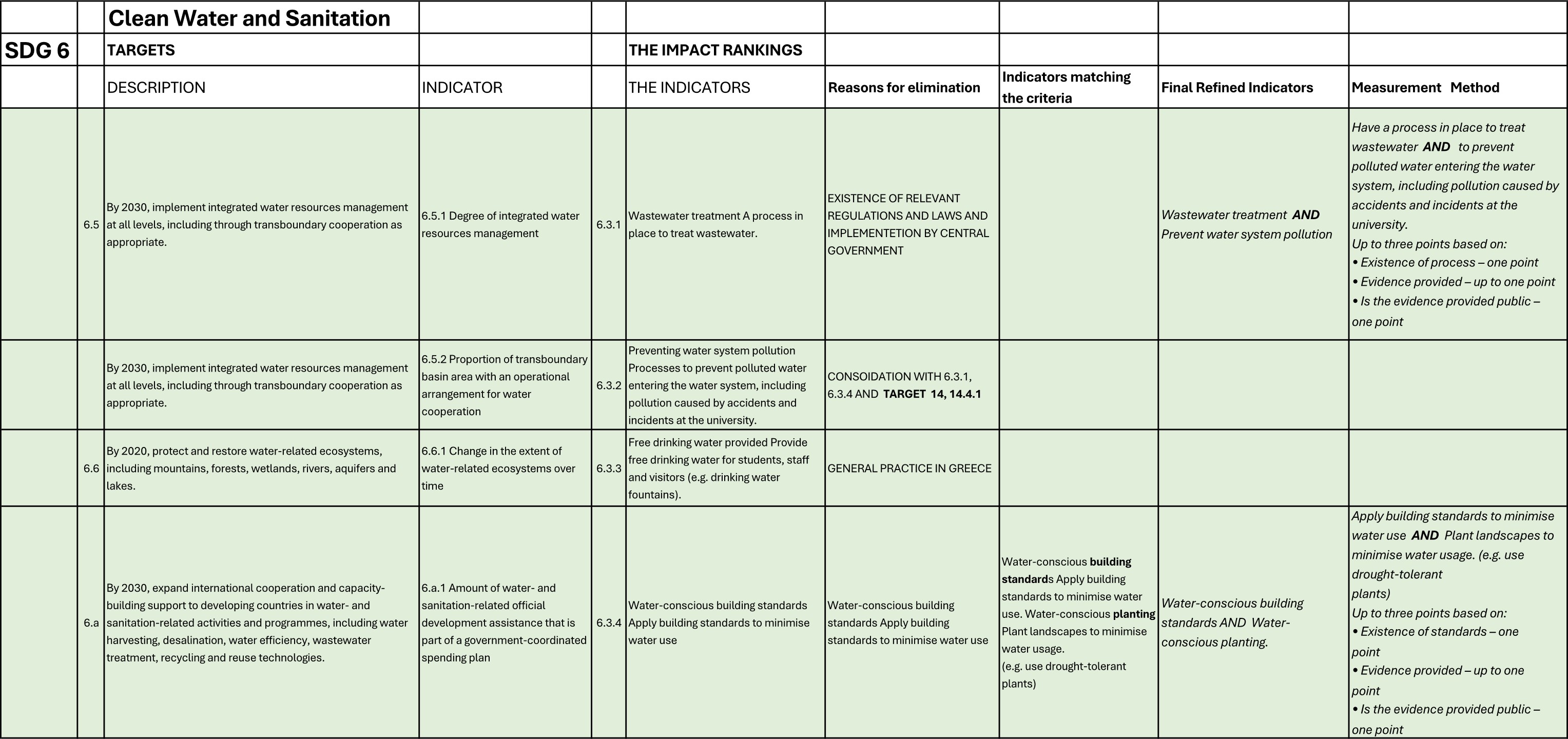Scopus Indexed
Scopus Indexed
Article Peer-Reviewed
Development Proposals for Implementing the 17 SDGs in Higher Education Institutions: Early Stages
Department of Environment, Ionian University, 29100 Zakynthos, Greece
*
For correspondence.
Academic Editor:
Received: 20 December 2023 Accepted: 14 May 2024 Published: 30 May 2024
Abstract
Universities, as key players in global development, have a vital role in implementing the Sustainable Development Goals (SDGs) within their environments. However, measuring progress toward the SDGs poses methodological challenges due to the complex framework comprising 17 goals, 169 targets, and 247 indicators. Within the diverse landscape of university ranking systems, in 2019 emerged the Times Higher Education Impact Rankings (THE IR) being so far the only ranking dedicated to evaluating the performance of Higher Education Institutions (HEIs) in relation to the SDGs. Despite its validation and participation, there are emerging issues, such as the need to consider local contexts and available resources. This study, originating from the Greek context, aims to serve as the initial stage in formulating a more practical and efficient assessment tool utilizing Multi-criteria Decision Making (MCDM/A), specifically by developing a streamlined set of indicators. Its primary objective is to introduce internationally applicable and unbiased indicators that can provide more accurate evaluations of universities’ progress, toward achieving the SDGs. To achieve this, various criteria were applied to an existing set of indicators, to determine their effectiveness in measuring SDG implementation. The findings of this analysis reveal the emergence of 34 indicators that meet the specified criteria.
Figures in this Article
 Figure 1
Figure 1
 Figure 2
Figure 2
 Figure 3
Figure 3
 Figure 4
Figure 4
Would you like to reuse the images? Contact the journal editorial office to obtain high-quality versions.
Keywords
Sustainable Development Goals; university; rankings; sustainability; higher education institutions; indicators; assessment tools; MCDM/A; AHP
Copyright © 2024
Martinis et al. This article is distributed under the terms of the Creative Commons Attribution License (CC BY 4.0), which permits unrestricted use and distribution provided that the original work is properly cited.
Funding
This research received no specific grant from any funding agency in the public, commercial, or not-for-profit sectors.
Cite this Article
Martinis, A., Kaloutsa, M., & Kabassi, K. (2024). Development Proposals for Implementing the 17 SDGs in Higher Education Institutions: Early Stages. Highlights of Sustainability, 3(2), 255–274. https://doi.org/10.54175/hsustain3020015
References
1.
Brundtland, G. H. (1987). Our Common Future: Report of the World Commission on Environment and Development. United Nations. http://www.un-documents.net/ocf-ov.htm (accessed 16 August 2022).
2.
Lozano, R., Lukman, R., Lozano, F. J., Huisingh, D., & Lambrechts, W. (2013). Declarations for sustainability in higher education: becoming better leaders, through addressing the university system. Journal of Cleaner Production, 48, 10–19. https://doi.org/10.1016/j.jclepro.2011.10.006
3.
United Nations. (2022). The 17 Goals. https://sdgs.un.org/goals (accessed 16 August 2022).
4.
Leal Filho, W., Shiel, C., Paço, A., Mifsud, M., Ávila, L. V., Brandli, L. L., et al. (2019). Sustainable Development Goals and sustainability teaching at universities: Falling behind or getting ahead of the pack? Journal of Cleaner Production, 232, 285–294. https://doi.org/10.1016/j.jclepro.2019.05.309
5.
Sachs, J. D. (2012). From millennium development goals to sustainable development goals. The Lancet, 379(9832), 2206–2211. https://doi.org/10.1016/S0140-6736(12)60685-0
6.
Stafford-Smith, M., Griggs, D., Gaffney, O., Ullah, F., Reyers, B., Kanie, N., et al. (2017). Integration: the key to implementing the Sustainable Development Goals. Sustainability Science, 12, 911–919. https://doi.org/10.1007/s11625-016-0383-3
7.
Annan-Diab, F., & Molinari, C. (2017). Interdisciplinarity: Practical approach to advancing education for sustainability and for the Sustainable Development Goals. The International Journal of Management Education, 15(2), 73–83. https://doi.org/10.1016/j.ijme.2017.03.006
8.
Leal Filho, W., Manolas, E., & Pace, P. (2015). The future we want: key issues on sustainable development in higher education after Rio and the UN decade of education for sustainable development. International Journal of Sustainability in Higher Education, 16(1), 112–129. https://doi.org/10.1108/IJSHE-03-2014-0036
9.
Leal Filho, W., Frankenberger, F., Salvia, A. L., Azeiteiro, U., Alves, F., Castro, P., et al. (2021). A framework for the implementation of the Sustainable Development Goals in university programmes. Journal of Cleaner Production, 299, 126915. https://doi.org/10.1016/j.jclepro.2021.126915
10.
Chaleta, E., Saraiva, M., Leal, F., Fialho, I., & Borralho, A. (2021). Higher education and sustainable development goals (SDG)—potential contribution of the undergraduate courses of the school of social sciences of the University of Évora. Sustainability, 13(4), 1828. https://doi.org/10.3390/su13041828
11.
Nogueiro, T., & Saraiva, M. (2023). TQM and SDGs for Erasmus+ Programme—Quality Education, Reducing Inequalities, Climate Change, Peace and Justice. Social Science, 12(3), 123. https://doi.org/10.3390/socsci12030123
12.
Chankseliani, M., & McCowan, T. (2021). Higher education and the sustainable development goals. Higher Education, 81, 1–8. https://doi.org/10.1007/s10734-020-00652-w
13.
Ferguson, T., & Roofe, C. G. (2020). SDG 4 in higher education: Challenges and opportunities. International Journal of Sustainability in Higher Education, 21(5), 959–975. https://doi.org/10.1108/IJSHE-12-2019-0353
14.
Nogueiro, T., & Saraiva, M. (2023). Quality and practices for Sustainability in Higher Education—An Impact Ranking approach. In A. Mesquita, A. Abreu, J. V. Carvalho, & C. H. P. de Mello (Eds.), Perspectives and Trends in Education and Technology. Smart Innovation, Systems and Technologies (Vol. 320, pp. 297–310). Springer, Singapore. https://doi.org/10.1007/978-981-19-6585-2_27
15.
Nogueiro, T, Saraiva, M, & Jorge, F. (2022). The Sustainable Development Goal 4 and the Impact Ranking: Quality Education in Portuguese Higher Education Institutions. Journal of Biomedical Research & Environmental Sciences, 3(11), 1353–1362. https://doi.org/10.37871/jbres1603
16.
Times Higher Education. (2019). Impact Rankings 2019. https://www.timeshighereducation.com (accessed 11 April 2022).
17.
De la Poza, E., Merello, P., Barberá, A., & Celani, A. (2021). Universities’ reporting on SDGs: Using the impact rankings to model and measure their contribution to sustainability. Sustainability, 13(4), 2038. https://doi.org/10.3390/su13042038
18.
Galleli, B., Teles, N. E. B., Santos, J. A. R. d., Freitas-Martins, M. S., & Hourneaux, F., Jr. (2022). Sustainability university rankings: A comparative analysis of UI green metric and the times higher education world university rankings. International Journal of Sustainability in Higher Education, 23(2), 404–425. https://doi.org/10.1108/IJSHE-12-2020-0475
19.
Bautista-Puig, N., Orduña-Malea, E., & Perez-Esparrells, C. (2022). Enhancing sustainable development goals or promoting universities? An analysis of the times higher education impact rankings. International Journal of Sustainability in Higher Education, 23(8), 211–231. https://doi.org/10.1108/IJSHE-07-2021-0309
20.
Calderon, A. (2023). Sustainability Rankings: What they are About and How to make them Meaningful. Journal of Studies in International Education, 27(4), 674–692. https://doi.org/10.1177/10283153231172022
21.
Lahdelma, R., Salminen, P., & Hokkanen, J. (2000). Using multicriteria methods in environmental planning and management. Environmental Management, 26(6), 595–605. https://doi.org/10.1007/s002670010118
22.
Sousa, M., Almeida, M. F., & Calili, R. (2021). Multiple criteria decision making for the achievement of the UN sustainable development goals: A systematic literature review and a research agenda. Sustainability, 13(8), 4129. https://doi.org/10.3390/su13084129
23.
Steuer, R. E., Gardiner, L. R., & Gray, J. (1996). A bibliographic survey of the activities and international nature of multiple criteria decision making. Journal of Multi‐Criteria Decision Analysis, 5(3), 195–217. https://doi.org/10.1002/(SICI)1099-1360(199609)5:3<195::AID-MCDA81>3.0.CO;2-D
24.
Leal Filho, W., Simaens, A., Paço, A., Hernandez-Diaz, P. M., Vasconcelos, C. R. P., Fritzen, B., et al. (2023). Integrating the Sustainable Development Goals into the strategy of higher education institutions. International Journal of Sustainable Development & World Ecology, 30(5), 564–575. https://doi.org/10.1080/13504509.2023.2167884
25.
Larrán Jorge, M., Herrera Madueño, J., Calzado, Y., & Andrades, J. (2016). A proposal for measuring sustainability in universities: a case study of Spain. International Journal of Sustainability in Higher Education, 17(5), 671–697. https://doi.org/10.1108/IJSHE-03-2015-0055
26.
Rieg, N. A., Gatersleben, B., & Christie, I. (2021). Organizational Change Management for Sustainability in Higher Education Institutions: A Systematic Quantitative Literature Review. Sustainability, 13, 7299. https://doi.org/10.3390/su13137299
27.
Rafols, I., Noyons, E., Confraria, H., & Ciarli, T. (2021). Visualising plural mappings of science for Sustainable Development Goals (SDGs). SocArXiv. https://doi.org/10.31235/osf.io/yfqbd
28.
Siegel, K. M., & Bastos Lima, M. G. (2020). When international sustainability frameworks encounter domestic politics: the sustainable development goals and agri-food governance in South America. World Development, 135, 105053. https://doi.org/10.1016/j.worlddev.2020.105053
29.
Caputo, F., Ligorio, L., & Pizzi, S. (2021). The Contribution of Higher Education Institutions to the SDGs—An Evaluation of Sustainability Reporting Practices. Administrative Sciences, 11, 97. https://doi.org/10.3390/admsci11030097
30.
Moggi, S. (2023). Sustainability reporting, universities and global reporting initiative applicability: a still open issue. Sustainability Accounting, Management and Policy Journal, 14(4), 699–742. https://doi.org/10.1108/SAMPJ-05-2022-0257
31.
del Mar Alonso-Almeida, M., Marimon, F., Casani, F., & Rodriguez-Pomeda, J. (2015). Diffusion of sustainability reporting in universities: current situation and future perspectives. Journal of Cleaner Production, 106, 144–154. https://doi.org/10.1016/j.jclepro.2014.02.008
32.
Klußmann, C., Sassen, R., & Gansel, E. (2019). Structural key factors of participatory sustainability reporting for universities. International Journal of Sustainability in Higher Education, 20(6), 1080–1098. https://doi.org/10.1108/IJSHE-08-2018-0139
33.
Velazquez, L., Munguia, N., Platt, A., & Taddei, J. (2006). Sustainable university: what can be the matter? Journal of Cleaner Production, 14(9–11), 810–819. https://doi.org/10.1016/j.jclepro.2005.12.008
34.
Bice, S., & Coates, H. (2016). University sustainability reporting: taking stock of transparency. Tertiary Education and Management, 22, 1–18. https://doi.org/10.1080/13583883.2015.1115545
35.
Fonseca, A., Macdonald, A., Dandy, E., & Valenti, P. (2011). The state of sustainability reporting at Canadian universities. International Journal of Sustainability in Higher Education, 12(1), 22–40. https://doi.org/10.1108/14676371111098285
36.
Smith, A. A. (1993). Campus Ecology: A Guide to Assessing Environmental Quality and Creating Strategies for Change. Living Planet Press.
37.
Sáez de Cámara, E., Fernández, I., & Castillo-Eguskitza, N. (2021). A holistic approach to integrate and evaluate sustainable development in higher education. The case study of the University of the Basque Country. Sustainability, 13(1), 392. https://doi.org/10.3390/su13010392
38.
Yarime, M., & Tanaka, Y. (2012). The Issues and Methodologies in Sustainability Assessment Tools for Higher Education Institutions: A Review of Recent Trends and Future Challenges. Journal of Education for Sustainable Development, 6(1), 63–77. https://doi.org/10.1177/097340821100600113
39.
Alghamdi, N., den Heijer, A., & de Jonge, H. (2017). Assessment tools’ indicators for sustainability in universities: an analytical overview. International Journal of Sustainability in Higher Education, 18(1), 84–115. https://doi.org/10.1108/IJSHE-04-2015-0071
40.
Fischer, D., Jenssen, S., & Tappeser, V. (2015). Getting an empirical hold of the sustainable university: a comparative analysis of evaluation frameworks across 12 contemporary sustainability assessment tools. Assessment & Evaluation in Higher Education, 40(6), 785–800. https://doi.org/10.1080/02602938.2015.1043234
41.
Association of University Leaders for a Sustainable Future (ULSF). (1999–2001). Sustainability Assessment Questionnaire (SAQ). https://ulsf.org (accessed 3 May 2022).
42.
Lozano, R. (2006). A tool for a Graphical Assessment of Sustainability in Universities (GASU). Journal of Cleaner Production, 14(9–11), 963–972. https://doi.org/10.1016/j.jclepro.2005.11.041
43.
Association for the Advancement of Sustainability in Higher Education (AASHE). (2006). Sustainability Tool to Assess Academic Research (STAAR). https://stars.aashe.org (accessed 22 March 2022).
44.
Simkins, G., & Nolan, A. (2004). Environmental management systems in universities. Occasional paper for the environmental association for universities and colleges (EAUC). https://www.sustainabilityexchange.ac.uk/files/emsiu-v5_1.pdf (accessed 4 April 2022).
45.
ProSPER.Net. (2009). Alternative University Appraisal (AUA). https://prospernet.ias.unu.edu/projects/past-projects/alternative-university-appraisal-aua (accessed 4 April 2022).
46.
Gómez, F. U., Sáez-Navarrete, C., Lioi, S. R., & Marzuca, V. I. (2015). Adaptable model for assessing sustainability in higher education. Journal of Cleaner Production, 107, 475–485. https://doi.org/10.1016/j.jclepro.2014.07.047
47.
University of Indonesia. (2014). UI Green Metric World University Rankings 2014. https://greenmetric.ui.ac.id (accessed 18 March 2022).
48.
Sulitest.org. (2013). Sulitest Tool. https://www.sulitest.org/en/index.html (accessed 3 May 2022).
49.
European Commission. (2018). A Regional Innovation Impact Assessment (RIIA) Framework for Universities. https://publications.jrc.ec.europa.eu/repository/handle/JRC109020 (accessed 27 May 2024).
50.
The Alliance for sustainability Leadership in Education. (2004). Sustainability Leadership Scorecard. https://www.eauc.org.uk/sustainability_leadership_scorecard (accessed 4 April 2022).
51.
Oikos-international. (2020). Org 1987 survey positive impact rating 2020 (For students).
52.
DECODE Sustainability. (2022). DECODE HEI Sustainability Analysis 2022. https://decode-council.org/index.php/resources (accessed 18 March 2022).
53.
Department of Economic and Social Affairs (DESA). (2022). The Sustainable Development Goals Report 2022. United Nations. https://unstats.un.org/sdgs/report/2022 (accessed 2 August 2023).
54.
Leal Filho, W., Coronado-Marín, A., Salvia, A. L., Silva, F. F., Wolf, F., LeVasseur, T., et al. (2022). International trends and practices on sustainability reporting in higher education institutions. Sustainability, 14(19), 12238. https://doi.org/10.3390/su141912238
55.
Shawe, R, Horan, W, Moles, R, & O’Regan, B. (2019). Mapping of sustainability policies and initiatives in higher education institutes. Environmental Science & Policy, 99, 80–88. https://doi.org/10.1016/j.envsci.2019.04.015
56.
Serafini, P. G., de Moura, J. M., de Almeida, M. R., & de Rezende, J. F. D. (2022). Sustainable development goals in higher education institutions: a systematic literature review. Journal of Cleaner Production, 370, 133473. https://doi.org/10.1016/j.jclepro.2022.133473
57.
Sepetis, A., Goula, A., Kyriakidou, N., Rizos, F., & Sanida, M. (2020). Education for the Sustainable Development and Corporate Social Responsibility in Higher Education Institutions (HEIs): Evidence from Greece. Journal of Human Resource and Sustainability Studies, 8, 86–106. https://doi.org/10.4236/jhrss.2020.82006
58.
Aleixo, A. M., Azeiteiro, U. M., & Leal, S. (2020). Are the sustainable development goals being implemented in the Portuguese higher education formative offer? International Journal of Sustainability in Higher Education, 21(2), 336–352. https://doi.org/10.1108/IJSHE-04-2019-0150
59.
Lauder, A., Sari, R. F., Suwartha, N., & Tjahjono, G. (2015). Critical review of a global campus sustainability ranking: GreenMetric. Journal of Cleaner Production, 108, 852–863. https://doi.org/10.1016/j.jclepro.2015.02.080
60.
Veidemane, A. (2022). Education for Sustainable Development in Higher Education Rankings: Challenges and Opportunities for Developing Internationally Comparable Indicators. Sustainability, 14, 5102. https://doi.org/10.3390/su14095102
61.
Saaty, T. (1980). The analytic hierarchy process (AHP) for decision making [PowerPoint slides]. Cash Flow Valuation. http://www.cashflow88.com/decisiones/saaty1.pdf (accessed 27 May 2024).
62.
Saaty, T. L., & Tran, L. T. (2007). On the invalidity of fuzzifying numerical judgments in the Analytic Hierarchy Process. Mathematical and Computer Modelling, 46(7–8), 962–975. https://doi.org/10.1016/j.mcm.2007.03.022
63.
de F. S. M. Russo, R., & Camanho, R. (2015). Criteria in AHP: a systematic review of literature. Procedia Computer Science, 55, 1123–1132. https://doi.org/10.1016/j.procs.2015.07.081
64.
Vaidya, O. S., & Kumar, S. (2006). Analytic hierarchy process: An overview of applications. European Journal of Operational Research, 169(1), 1–29. https://doi.org/10.1016/j.ejor.2004.04.028
65.
Mu, E., & Pereyra-Rojas, M. (2017). Understanding the Analytic Hierarchy Process. In Practical Decision Making. Springer Briefs in Operations Research. Springer, Cham. https://doi.org/10.1007/978-3-319-33861-3_2
66.
Chen, C.-W., Wang, J.-H., Wang, J. C., & Shen, Z.-H. (2018). Developing indicators for sustainable campuses in Taiwan using fuzzy Delphi method and analytic hierarchy process. Journal of Cleaner Production, 193, 661–671. https://doi.org/10.1016/j.jclepro.2018.05.082
67.
Saaty, T. L. (2008). Decision making with the analytic hierarchy process. International Journal of Services Sciences, 1(1), 83–98. https://doi.org/10.1504/IJSSCI.2008.017590
68.
Goepel, K. D. (2013). Implementing the analytic hierarchy process as a standard method for multi-criteria decision making in corporate enterprises—a new AHP excel template with multiple inputs. In Proceedings of the International Symposium on the Analytic Hierarchy Process (Vol. 2). Creative Decisions Foundation.
69.
Horan, W., & O’Regan, B. (2021). Developing a Practical Framework of Sustainability Indicators Relevant to All Higher Education Institutions to Enable Meaningful International Rankings. Sustainability, 13, 629. https://doi.org/10.3390/su13020629
70.
Sepasi, S., Rahdari, A., & Rexhepi, G. (2018). Developing a sustainability reporting assessment tool for higher education institutions: The University of California. Sustainable Development, 26, 672–682. https://doi.org/10.1002/sd.1736
71.
Zhu, Y., & Buchmann, A. (2002). Evaluating and selecting web sources as external information resources of a data warehouse. In Proceedings of the Third International Conference on Web Information Systems Engineering 2002 (pp. 149–160). IEEE.
72.
Findler, F., Schönherr, N., Lozano, R, & Stacherl, B. (2019). Assessing the Impacts of Higher Education Institutions on Sustainable Development—An Analysis of Tools and Indicators. Sustainability, 11(1), 59. https://doi.org/10.3390/su11010059
73.
Lozano, R., Ceulemans, K., Alonso-Almeida, M., Huisingh, D., Lozano, F. J., Waas, T., et al. (2015). A review of commitment and implementation of sustainable development in higher education: results from a worldwide survey. Journal of Cleaner Production, 108, 1–18. https://doi.org/10.1016/j.jclepro.2014.09.048
74.
Caeiro, S., Hamón, L. A. S., Martins, R., & Aldaz, C. E. B. (2020). Sustainability assessment and benchmarking in higher education institutions-a critical reflection. Sustainability, 12(2), 543. https://doi.org/10.3390/su12020543
Metrics
Loading...
Journal Menu
Journal Contact
Highlights of Sustainability
Editorial Office
Highlights of Science
Avenida Madrid, 189-195, 3-3
08014 Barcelona, Spain
08014 Barcelona, Spain
Cathy Wang
Managing Editor